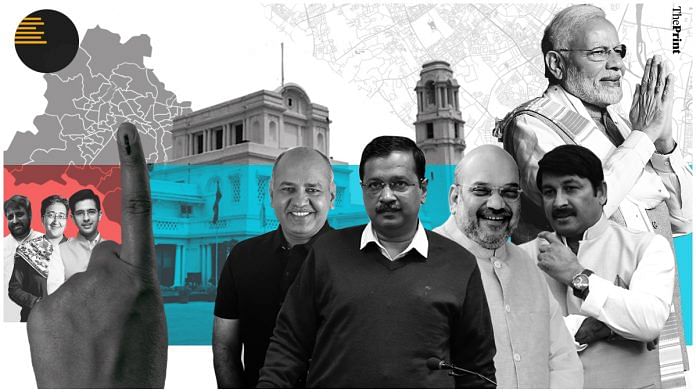Arvind Kejriwal’s AAP is headed for a sweeping victory in the Delhi assembly election after securing 62 out of the total 70 seats, while Modi-Shah’s BJP trails behind at 8 seats. The Congress, just like 2015, has secured zero seats.
ThePrint asks: What lessons should Narendra Modi, Amit Shah & Arvind Kejriwal draw from Delhi election?
BJP must realise that negative campaigns don’t work while AAP now faces the challenge of expanding party base
 Gilles Verniers
Gilles Verniers
Co-Director, Trivedi Centre for Political Data and assistant professor, Ashoka University
The lesson that the BJP leadership needs to learn from the Delhi assembly election is that negative campaigns defined by personal attacks, hate speech and disinformation do not work when they are not obfuscated by an encompassing positive message meant to attract voters situated outside the party’s support base.
Since the 2019 Lok Sabha election, the BJP has lost three state assembly elections and has been forced to enter into a coalition in the fourth state — Haryana. In all these cases, it lost roughly twenty per cent of the vote share it obtained in 2019. The generic nationalist rhetoric used by the BJP in Lok Sabha campaigns and the projection of the prime minister as a providential figure simply do not compensate for the party’s organisational weakness on the ground, notably the lack of rallying figures. Even the formidable machinery that the BJP deploys at great cost in every election is not a substitute for clear messaging and effective local leadership.
As far as the AAP is concerned, its sweeping victory in Delhi places the party into the following conundrum: how to expand the party’s base and organisation when it campaigns on the basis of local achievements? While the technocratic approach adopted by the AAP in its campaign may work in Delhi – where it does have tangible achievements to its credit – it would be insufficient to help the party expand beyond the borders of the national capital. As of now, Arvind Kejriwal has made no statements about AAP’s future ambitions, which may indicate the party’s desire to focus on the mandate it has just received.
Congress can learn from BJP on how to fight back while AAP must stop blaming Modi govt now
 Seshadri Chari
Seshadri Chari
Former editor of Organiser
The AAP deserves all credit for putting up a spirited fight and posting a spectacular victory in the Delhi assembly election. What helped the AAP was the perception that it had provided good governance, even though it’s not entirely true. In the second term, the AAP’s leadership should put its best foot forward and work more instead of blaming the central government.
The BJP’s strategy worked very well to increase its vote share but it didn’t win the party more seats than 2015. The Congress’ failure in securing enough votes hurt the BJP the most. Besides, the party fought it all alone this time.
The voter profile of Delhi has changed since India’s independence. The BJP should have projected a local leader equivalent of AAP’s Kejriwal. The BJP’s dependence on the top brass does not always work to its advantage in states. The Modi-Shah duo should reserve national issues only for Lok Sabha elections. The overemphasis on CAA and related issues may have had a counterproductive effect on Delhi voters. Moreover, contesting elections without having a chief ministerial face may have been productive for the BJP in other states but not in Delhi where Kejriwal is a formidable opponent. (moved down)
If there’s one thing that the Congress should learn from the BJP, it is the determination to fight back. The revival of the Congress will be a closed chapter very soon because Bihar and West Bengal assembly elections will offer little chance for the party to show its strength.
AAP won due to TINA factor, creating mix of Hindutva & development, appropriating BJP’s strategy of nationalism
 Ashutosh
Ashutosh
Former AAP member
The outcome of the Delhi election shows a positive vote for the AAP and people’s rejection of politics of hatred. There are three factors that proved vital for AAP’s victory.
First, the ‘There is no Alternative’ (TINA) factor worked for Kejriwal like it worked for Modi during the 2019 Lok Sabha election. In the 2020 Delhi election, BJP did not have a leader of stature to match up to Kejriwal.
Second, Kejriwal smartly created a cocktail of development and Hindutva and successfully appropriated the BJP’s strategy of nationalism, minus the hatred. The AAP continually raised slogans of ‘Bharat Mata ji jay’, supported the dilution of Article 370 and vaguely opposed the CAA. Then, it refused to be drawn into the Shaheen Bagh controversy and Kejriwal was still able to project himself as a Hindu-vote appeaser. His reciting the Hanuman chalisa was a masterstroke. This made the BJP’s nationalism, which always harps on an anti-Muslim rhetoric, appear negative.
Finally, freebies worked wonders for the poor — a vote base that had supported the Congress in the past. In the 2015 Delhi assembly election, these voters shifted to the AAP, and in this election, the base was further consolidated. No wonder the Congress disappeared in this election and allowed no division of anti-BJP votes, which eventually turned out to be a boon for the AAP.
Delhi election has taught Modi, Shah & Kejriwal that a polarising CM candidate is less likely to win state polls
 Neelanjan Sircar
Neelanjan Sircar
Assistant professor, Ashoka University & Visiting senior fellow, Centre for Policy Research
The 2020 Delhi assembly election has taught Narendra Modi, Amit Shah and Arvind Kejriwal that a polarising chief ministerial candidate is less likely to be electorally successful in state elections, especially in a city-state like Delhi. The national capital is a small region, which houses diverse migrants from across the country in its many colonies. So, Delhi is not big enough like Uttar Pradesh where identity-based politics can work.
For Delhi voters in this election, the focus on providing good governance and basic services turned out to be more valuable. Former CMs like Sheila Dixit knew this and similarly campaigned along the lines of development and public welfare.
The BJP, which hasn’t been in power in Delhi for nearly two decades, needs to learn that credentials of good state governance matter and so does announcing a strong CM candidate. Modi and Shah are willing to be less competitive in states in order to centralise power in the country and within the BJP. In trying to bolster his own power, the last thing Modi wants is a regional leader with his own vote base.
Strong regional leaders can create factionalism within the party. We need not look beyond the example of Indira Gandhi’s attempts to stamp out regional leaders in the 1970s by manipulating state institutions instead of investing in state units to counter the opposition.
BJP must reflect that CAA was ill-timed and AAP’s Kejriwal must remain a centrist leader in second term
 Malini Bhattacharjee
Malini Bhattacharjee
Assistant Professor, Azim Premji University
The BJP may have won a few more seats than its 2015 tally, but its defeat in the Delhi election should act as a reality check that it has become complacent. While it is politically naïve to attribute the anti-CAA rage as the sole reason for the BJP’s loss in Delhi, the party will have to reflect that the CAA was ill-timed. Indian Muslims perceive it as part of a larger sequence of the Modi government’s decisions — abolishing triple talaq, diluting Article 370, promising Ram Mandir — to humiliate them.
The ambiguity surrounding CAA and its perceived link with the NRC have clearly induced fears among Indian Muslims and angered liberal citizens of other faiths too. Moreover, a polemical vocabulary steeped in hyper-nationalism and in some cases bordering hatred against the ‘protesters’ has damaged the BJP’s reputation. The insensitive handling of student protests in several universities and the failure of the BJP’s leadership to condemn the first shooting in Shaheen Bagh clearly did not go down well with the electorate.
As for Arvind Kejriwal, his existing solid public support in Delhi and his ability to tread a somewhat centrist position against the backdrop of the anti-CAA protests ensured the AAP’s victory. Kejriwal should stick to doing this balancing act and be wary of swinging on either side of the political spectrum.
Also read: Has CAG Siachen report exposed Modi govt’s muscular national security pitch as hollow?
By Pia Krishnankutty, journalist at ThePrint







Iss par toh kitaab likhi jaa sakti hai. 2. In one sentence, Kaam bolta hai. In Delhi, challenger and incumbent both had a six year track record to showcase, although at different levels of the food chain. Had there been any sparkling achievements at national or global level, they should have been placed before the electorate. Even if Delhiites gave more weightage to local issues, they would have felt happy and proud. 3. It is extraordinarily insensitive to inject sentiments like Goli maaro saalon ko into a serious election campaign. Delhi Police have let down the citizens and may in fact have contributed to showing their political masters in a poor light. 4. There are many lessons to be learnt. We can only hope and pray that the right ones are. Senior journalist Neerja Choudhary has written that in a four decade career, she has never seen a more depraved campaign.